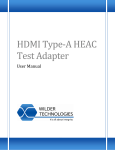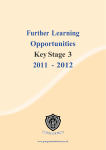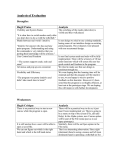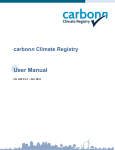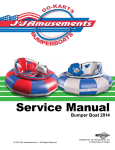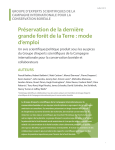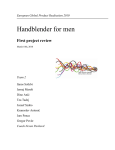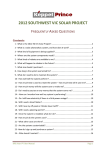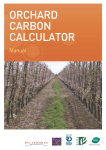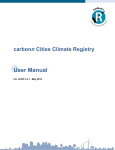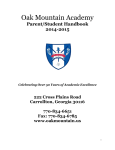Download School Footprint Calculator - Calgary Board of Education
Transcript
Developed by the Calgary Board of Education and the University of Calgary, the EcoFootprint Calculator USER MANUAL is a tool designed to assist K-12 schools and postsecondary institutions organizational in ecological reducing footprints their through education, engagement, and measurement of collective action. This manual provides guidelines on how to use and implement the calculator. Although specifically designed for educational institutions, anyone is invited to use the tool and tailor it to their organizations specific goals and needs. Thanks in part to TD Friends of the Environment Foundation, the City of Calgary, EPA Victoria and Anielski Management for development of this tool. ANIELSKI Management Inc. supporting the Table of Contents Introduction __________________________________________________ 3 What are footprint calculators? __________________________________ 3 Ecological Footprint _________________________________________________ 3 Carbon Footprint ___________________________________________________ 4 The EcoFootprint Calculator______________________________________ 5 How is the Eco-Footprint Calculator organized? ______________________ 6 What do I do first? _____________________________________________ 6 How to Complete Part I: Facility & Central Operations Data ____________ 7 How to Complete Part II: School Unit Data __________________________ 8 Part I: Facility & Central Operations Data __________________________ 10 Part II: School Unit Data________________________________________ 14 Appendix A: Daily commuting questionnaire _______________________ 23 Appendix B: Eco-Footprint Calculator Technical Data ________________ 25 2 Introduction This guide has been designed to supplement the use of the Calgary Board of Education (CBE) Ecological Footprint (EcoFootprint) Calculator. The Calculator is intended primarily for education and learning purposes. While not a partner in the project, we would like to recognize and sincerely thank the Victoria, Australia Environmental Protection Agency (EPA) for allowing us to model our ecological footprint calculations after the Environmental Protection Agency School Footprint Calculator. What are footprint calculators? Footprint calculators are accounting tools that follow the material and energy flows of a defined population and given current technology, and determine the environmental impact of these material and energy flows. Footprint calculators can be used to identify wasteful enterprises and to make well informed strategic choices to meet future sustainability goals. Ecological and carbon footprint calculators are the two most commonly used calculators and are widely available online. Some are designed on the small scale for individuals and households, while others can account for the consumption habits and waste streams of businesses, governments and nation states. The standard per capita measurement of both ecological and carbon footprints allows people from all around the world to compare footprints, regardless of where they live. Ecological Footprint The concept of the ecological footprint was pioneered by Mathis Wackernagel and William Rees at the University of British Columbia in the early 1990s. An ecological footprint measures the amount of land/water area necessary to sustain the resource consumption and waste assimilation associated with a defined population given current technology levels. Ecological footprints are generally measured in global hectares (gha), where one global hectare is equivalent to one hectare of land with the global average level of productivity. This measurement only accounts for productive lands and excludes areas like ice caps and deserts. One of the strengths of the global hectare measurement is that it provides a concrete, easy-tounderstand, visual indication of our impact. 3 It has been determined that the world is capable of providing 1.8 gha of productive land for every person on the planet. Presently, the average ecological footprint of the world’s population per capita is 2.3 gha, which exceeds the Earth’s carrying capacity by roughly 30 percent. Phrased differently, based on current consumption levels, the global population requires roughly 1.3 planets to support its consumption levels. Here in Canada, our average ecological footprint is much higher than the global average and rests at about 7.8 gha per person. According to a 2005 assessment by the Federation of Canadian Municipalities, Calgary has the largest ecological footprint of any metropolitan city in Canada. If all humanity adopted the same consumptive lifestyle of the average Calgarian, humanity would require 5 planet earths to support its consumption levels. Carbon Footprint The carbon footprint is a subcategory of the ecological footprint and reports the amount of carbon dioxide waste produced by a population. The calculation focuses on how burning fossil fuels contributes to increasing concentrations of CO2 and other greenhouse gases in the Earth’s atmosphere. When examined alone, the carbon footprint is usually reported in tonnes of equivalent carbon dioxide (CO2e). This unit captures the radiative forcing caused by CO2 as well as other greenhouse gases like methane, water vapour and ozone. When used as part of the ecological footprint it is necessary to convert CO2e into hectares. This is done by determining the amount of average carbon-sink forest area necessary to sequester the given amount of CO2e. 4 The EcoFootprint Calculator The EcoFootprint Calculator is an exciting, new, learning tool that can be used to estimate the carbon and ecological footprint of your school. The Calculator is the first of its kind in North America and is designed to capture the energy and material demands associated with building operations, transportation and purchasing over the course of a 12-month period. The Calculator reports both an ecological footprint estimate, in global hectares, and a carbon footprint estimate, in tonnes CO2e. While designed primarily as a learning tool, some schools may choose to use the calculator to inform future sustainability goals. Once your school has determined its footprint, consider becoming an EcoSite. The EcoSites program provides an excellent steppingoff point to support meaningful environmental action at your school. For more information about EcoSites, please refer to the CBE EcoStewardship website: http://www.cbe.ab.ca/community/ecoStewardship/ecosites.asp Please note: The EcoFootprint Calculator does not estimate the personal carbon footprint or ecological footprint of staff and students, but rather the footprint of the community. To estimate your individual ecological footprint please refer to the Calgary Personal Ecological Footprint Calculator which can be accessed through the City of Calgary website. Your comments are appreciated We appreciate your feedback! If you have any suggestions on how we can improve the EcoFootprint Calculator, Technical Document or this User Manual please contact the CBE EcoTeam at [email protected]. Disclaimer Calculator results are an approximation only and should only be used to estimate the carbon and ecological footprint of your school. These results should serve as a guide only and do not substitute for formal professional advice. 5 How is the Eco-Footprint Calculator organized? The EcoFootprint Calculator is divided into two parts that encompass seven categories; Part I focuses on the footprint associated with facility and central operations and Part II summarizes school specific transportation and purchasing data. For simplicity, categories in Part I are coded in green and categories in Part II are coded in blue. General Outline of the Eco-Footprint Calculator Part I: Facility & Central Operations Data - 1.Building operations energy - 2. Fleet central operations - 3. Waste Part II: School Unit Data - 4. Daily commuting - 5. Travel- Business, education, sports - 6. Purchasing- Office supplies - 7. Purchasing- Food & beverages To help you complete the EcoFootprint Calculator, checklists are provided for each Part I and Part II, outlining what data is necessary and how to correctly input data into the Calculator. Categories in Part I and Part II will likely need to be completed by different specialists in your school and certain sections will require the help of central operations staff. What do I do first? If your school is interested in completing their footprint calculations, please contact the CBE EcoTeam at [email protected]. A member of the team will be in touch with you to provide you with a school specific calculator with facility & central operations data filled in, and to walk you through how to fill out the various parts of the calculator that need school input. When entering data it is important to note that the calculator is meant to assess your school footprint over the course of a 12-month period encompassing one full school year from September to the following August. Please enter calculator values accordingly. 6 How to Complete Part I: Facility & Central Operations Data Part I consists of categories 1-3 and will, for the most part, be completed by central operations staff. The following checklist provides a summary of what data is needed and where it can be found in order to complete the calculator. More information on the required information is provided in the pages following the checklists. Part I Checklist: 1. Building operations energy (for more information turn to page 10) Required Information 1. What is the amount of natural Source Staff member School Central operations Operations Check CBE EcoTeam x gas (cubic feet) consumed in one school year for your building? 2. What is the amount of electricity CBE EcoTeam x (kilowatt hours) attributed to your building in one school year? 2. Fleet central operations (for more information, turn to page 10) 1. What is the amount of fuel (L), Esso and Shell fuel by fuel type, used by grounds, consumption reports (FES maintenance and distribution? Financial Services) x 3. Waste (for more information, turn to page 11) School operations 1. What is the total amount of CBE EcoTeam ( Waste & waste (lbs, kg, tonnes) sent to Recycling Coordinator) x landfill from your school? 2. What is the total amount of CBE EcoTeam (Waste & mixed paper/card board (lbs, kg, Recycling Coordinator) x tonnes) sent for recycling from your school? 3. What is the total amount of Contact the facility operator x 7 beverage containers (lbs, kg, or environmental student club tonnes) sent for recycling from at your school to estimate the your school? weight of beverage containers recycled 4. What is the total amount of food If your school has a discards (lbs, kg, tonnes) composting program contact composted at your school? the teacher sponsor and x estimate the weight of organics composted Central operations 1. What is the total amount of waste (lbs, kg, tonnes) sent to landfill from central operations? 2. What is the total amount of mixed paper/card board (lbs, kg, tonnes) sent for recycling from central operations? 3. What is the total amount of textbooks (lbs, kg, tonnes) sent for recycling? 4. What is the total amount of computer/ ewaste sent to recycling? 5. What is total amount of leaf and lawn waste sent to compost? 6. What is total amount of scrap metal sent to recycling? CBE EcoTeam (Waste & Recycling Coordinator) x CBE EcoTeam (Waste & Recycling Coordinator) CBE EcoTeam (Waste & Recycling Coordinator) CBE Warehouse Services x x x 0 x 15000 kg x How to Complete Part II: School Unit Data Part II consists of categories 4-7 and should be completed with help from an administrative staff member who has access to administrative records including travel records for school related business, education and sporting trips as well as purchasing expenditures. The following checklist provides a summary of what data is needed and where it might be found in order to complete the calculator. More information on the required information is provided in the pages following the checklists. 8 Part II Checklist: 4. Daily commuting (for more information, turn to page 14) Required Information Source For each transportation category of the commuting survey determine: (a) the total number of trips, (b) the total km of trips taken Data obtained and estimated using a daily commuting survey administered to entire school population (including staff) Check 5. Travel- Business, education, sports (for more information, turn to page 17) 1. & 2. Personal vehicles and School/coach bus travel Number of personal vehicles or school/coach buses used by staff and students when traveling on schoolrelated trips within Calgary or to Canmore, Lethbridge or Edmonton. *For other destinations you will need to determine the number of km traveled in a roundtrip. 3. Air travel: Number of staff and students travelling on schoolrelated trips to Saskatoon, Seattle, Vancouver, Toronto, Ottawa or Montreal. *For other destinations you will need to determine the kg of C02 emitted in a round trip. Someone with knowledge of schoolrelated trips taken at your school Use the Travel in Alberta: Distance Calculator. Someone with knowledge of schoolrelated trips taken at your school Use the Atmospheric Flight Emissions Calculator. 6. Purchasing- Office supplies (for more information, turn to page 20) By recycled paper content, enter the quantity of copy paper consumed in reams or boxes. Examine the school budget to determine the type and quantity of paper purchased. Enterer the amount of money spent on each category: - Journals, magazines and newspapers - Produced printed materials and publications - Other stationary - Computers and printer equipment - Toners Examine the school budget to determine the amount of money spent on each supply category. 7. Purchasing- Food & beverages (for more information, turn to page 21) Enter the amount spent for each food and beverage category: - Catering: including meat and/ or dairy - Catering: vegetarian - Business meals: including meat and/ or dairy - Business meals: vegetarian - Tea and coffee supplies Examine the school budget to determine the amount of money spent on each food and beverage category. 9 Part I: Facility & Central Operations Data Category 1: Building operations energy Building operations energy captures the direct amount of fuel and electricity required to operate your school building over the last school year. This category will a) Already be completed for you or b) should be completed by your school’s operations staff member with the help of central operations staff. What is needed to complete this category: o The total amount of natural gas consumed by your school (cubic feet) o The total amount of electricity used by your school (kilowatt hours) Building operation energy instructions: 1. Contact the CBE EcoTeam at [email protected] . Request your school’s natural gas and electricity consumption data for one full year (September to August). 2. Enter these values into the Calculator. Category 2: Fleet central operations [Completely filled out by central operations staff] Fleet central operations accounts for the amount of fuel consumed by CBE centrally owned and operated vehicles. These are vehicles that serve the entire school system and include grounds maintenance, mail distribution, etc. Using a square footage factor, a percentage of the total footprint from the central fleet is distributed to each school. What is needed to complete this category: o Total CBE fleet fuel consumption data for grounds and distribution (litres) Fleet central operations instructions: The CBE grounds fleet is composed of vehicles that are powered by gasoline and by diesel. The CBE has contracts with both Esso and Shell. Every month, fuel consumption reports are issued specifying the number of litres of gasoline and diesel purchased. Litre information is contained on the Financial Summary – Period to Date page in the Esso reports and on the first page of the 10 Monthly Shell Inventory reports. Contact FES Financial Services, to obtain the Esso and Shell fuel consumption reports for the last twelve months. Enter these values into the Calculator. Category 3: Waste [Partially filled out by central operations staff] The waste category refers to the amount of waste going to landfill or being recycled. The category is divided into school operations and central operations. The school operations section should be completed with help from your school’s operations staff member and with the help of central operations staff. The central operations waste section consists of waste and recycling streams that are not tracked by individual schools. The footprint associated with centrally collected waste and recycle streams will be distributed proportionally to all CBE schools based on school square footage. The central operations section of the waste category is completed by central operations staff at the CBE on behalf of your school. What is needed to complete this category: o The amount of waste going to landfill or being recycled by waste section (lbs, kg, tonnes) a) - School operations Mixed solid waste Mixed paper/ cardboard Beverage containers Food discards b) - Central operations [For central operations staff] Mixed solid waste Mixed paper/ cardboard Text books Computers/ ewaste Leaf and lawn waste Furniture 11 Waste instructions: a) School Operations •Mixed solid waste: You will need to contact the Waste and Recycling Coordinator to successfully complete the next two sections. The Waste and Recycling Coordinator tracks the volume of waste and recycling (if your school is on a central contract) that your school produces in one school year. Assuming 1 cubic yard of mixed solid waste = 79.2lbs, estimate the weight of mixed solid waste sent to landfill by your school each year. •Mixed paper/ cardboard: Assuming 1 cubic yard of mixed paper/ cardboard = 139lbs, estimate the weight of mixed paper/ cardboard recycled by your school each year. •Beverage containers: Contact the individual/group responsible for beverage container recycling at your school; this may be a facility operator, or a student environmental club. With help from the beverage container recycling contact, estimate the weight of beverage containers recycled each year. Student volunteers could weigh the amount of beverage containers collected in a week. Assume a 40 week school year to estimate the weight of beverage containers collected in the course of the school year. Be sure to convert the weight of containers collected into one of the units used in the Calculator (lbs, kg, tonnes) and input this number into the Calculator. •Food discards: If your school has created a formally managed composting program, contact the composting program teacher or administrative sponsor directly. With help from the sponsor to try and estimate the weight of organics recycled each year. If the composting program is spearheaded by a student group or class, have students weigh the amount of organics they collect in a week. Assume a 40 week school year to estimate the weight of organics being composted in the course of the school year. Be sure to convert the weight of organics composted into one of the units used in the Calculator (lbs, kg, tonnes) and input this number into the Calculator. b) Central operations [For central operations staff] •Mixed solid waste: This value is the amount of waste generated by Highfield and the Education Centre. This data is obtained from the Waste and Recycling Coordinator. •Mixed paper/ cardboard: 12 This value is the amount of mixed paper/cardboard generated by Highfield and the Education Centre. This data is obtained from the Waste and Recycling Coordinator. •Text books: Contact the Shipper/Receiver in the Highfield Warehouse. The Shipper/Receiver tracks the number of pallets of textbooks that are delivered to Capital paper through the course of the year. Using the tracking slips, determine the number of pallets recycled in the previous year. Assuming 1 pallet = 2170 kg, estimate the weight of textbooks recycled in kg over the course of the pervious year. •Computers/ ewaste: Contact the Warehouse Supervisor to obtain this data. •Leaf and lawn waste: CBE maintenance no longer collects leaf waste or grass clippings. Instead these materials are mulched and remain onsite. The amount of material mulched on site is not tracked, so this value is not available for the calculation. •Scrap Metal: In the past, the CBE recycled scrap metal from furniture using Navaho Metal Recycling. This arrangement ended, and now an independent contractor picks up all recycled metal. Since the CBE no longer derives a profit, the weight of this metal is not tracked. In 2008, 15000 kg of metal was recycled by Navaho. Use this as the scrap metal term. 13 Part II: School Unit Data Category 4: Daily commuting The daily commuting category refers to how staff and students travel to and from school during the school year. For this category you will need staff and students to complete a commuting survey. The survey can be delivered in 2 ways: 1. Hard copy (example provided in Appendix A) 2. Online through a survey tool A member of the EcoTeam will help design and deliver the commuting survey your school chooses to use. What is needed to complete this category: o Distribute the survey to all staff and students at your school. o Input aggregated data from completed surveys into the Calculator. o Determine the number of individuals who did not complete the survey and follow the instructions on how to account for uncompleted surveys. Basic method: Identify one primary mode of transportation and tabulate uncompleted surveys in this category. Detailed method: Identify multiple modes of transportation and tabulate uncompleted surveys in these categories. Daily commuting instructions: 1. Determine the best method to distribute the daily commuting survey to staff and students at your school (online or hard copy) and dispense the survey. 2. On the cut-off date of your choosing, determine the total number of trips and the total km travelled for each mode of transportation included in the survey. 3. Since the survey is meant to capture the daily commuting footprint associated with all staff and students it is important to account for individuals who did not complete the survey. To determine the number of uncompleted surveys subtract the number of completed surveys from the number of full-time staff and students at your school. 14 4. To account for uncompleted surveys you will need to determine the average weekly commute and primary mode(s) of transportation used by staff and students. Start by calculating the average weekly commute of staff and students (see Example 1). Example 1: Calculating average weekly commute Given: 15 individuals taking the survey 1. Determine the average daily commuting length (1+3+5+3+3+5+4+6+1+1+3+4+4+8+10)/15 ≈ 4 km 2. Determine the average weekly commute (assuming 10 one-way trips) 4 km x 10 one-way trips per week = 40 km 5. Next, tease out the dominant trend in transportation preference. It is to your discretion whether you would like to identify one or more mode of transportation. If you choose to identify multiple modes of transportation, come up with an approximate percentage for each transportation mode ensuring that the percentages you assign adds to 100 percent (see Example 2b: Example 1). 6. For each transportation category estimate: o The total number of trips taken (Example 2: Equation 2) Use the assumption that an individual takes 10 one-way commuting trips each week, and multiply the number of surveys attributed to each category by 10. Add this result to the analogous “completed survey total” and enter it into the calculator. o The total km (Example 2: Equation 3) 15 Multiply the number of surveys attributed to each category by the length of the weekly commute. Add this result to the analogous “completed survey total” and enter it into the calculator. Example 2: Accounting for uncompleted surveys Given: 45 uncompleted surveys a) Basic approach: One mode of transportation Transportation Percent Equation 1 # surveys Equation 2 category in each (total trips) category 2-person 100 45 surveys x 45 surveys 45 surveys x carpool in a car 100% 10 one-way trips b) Detailed approach: Multiple modes of transportation Transportation Percent Equation 1 # surveys Equation 2 category in each (total trips) category 2-person 65 45 surveys x 29 surveys 45 surveys x carpool in a car 65% 10 one-way trips School bus 25 45 surveys x 11 surveys 45 surveys x 25% 10 one-way trips Walking 10 45 surveys x 5 surveys 45 surveys x 10% 10 one-way trips Equation 3 (total km) 45 surveys x Avg. weekly commute Equation 3 (total km) 29 surveys x Avg. weekly commute 11 surveys x Avg. weekly commute 5 surveys x Avg. weekly commute 16 Category 5: Travel- Business, education, sports The travel category refers to school-related business, education and sports trips taken in the last school year. This category should be completed with the help of an administrative staff member who tracks all school-related trips. Examples of school-related trips include: teacher and staff professional development days off-site, teacher and staff school-supported conferences, class field trips, class-specific educational trips (i.e. Quebec Trips) and sporting tournaments. For simplicity, this category is divided into three sections base on the method of transportation used; sections include trips taken by a) personal vehicles, b) school and coach bus, and c) air travel. What is needed to complete this category: o Information required for trips taken by personal vehicle, school bus or coach bus: - The number of vehicles used for round trips within Calgary (round trip ≈ 10 km, ≈ 20 km, ≈ 50 km) and to Canmore, Lethbridge and Edmonton. - For other destinations you will need to determine the km traveled in a round trip using a distance calculator. o Information required for air travel: -The number of staff and students travelling round trip to Saskatoon, Seattle, Vancouver, Toronto, Ottawa or Montreal. (exclude chaperones) - For other destinations you will need to determine the kg of C02 emitted in a round trip using the Atmospheric Flight Emissions Calculator. Travel- Business, education, sports instructions: a) Personal vehicles Identify school-related events that staff and students attended using personal vehicles over the last school year. For trips within Calgary (round trip ≈ 10 km, ≈ 20 km, ≈ 50 km) and to Canmore, Lethbridge and Edmonton determine the number of vehicles used to attend the event. If you would like to include any additional travel routes, use an online distance calculator to determine the number of km travelled in a round trip. 17 Please note: The distance the travel calculator returns a one-way distance and so be sure to double this number before entering it into the Calculator. o Travel in Alberta: Distance Calculator http://www.travelinalberta.com/Mileage.cfm?PageID=532 b) School and coach bus Identify school-related events that staff and students attended using school and coach buses over the last school year. For trips within Calgary (round trip ≈10 km, ≈20 km, ≈50 km), Canmore, Lethbridge and Edmonton determine the number of vehicles used to attend the event. If you would like to include any additional travel routes, use an online distance calculator to determine the number of km travelled in a round trip. Please note: The distance the travel calculator returns is a one-way distance, so be sure to double this number before entering it into the Calculator. o Travel in Alberta: Distance Calculator http://www.travelinalberta.com/Mileage.cfm?PageID=532 c) Air travel Identify school-related events that staff and students attended using air travel over the last school year. For trips to Saskatoon, Seattle, Vancouver, Toronto, Ottawa and Montreal determine the number of staff and students who used air travel. For simplicity exclude any parent chaperones. If you would like to include an additional travel route(s), use the Atmospheric Flight Emissions Calculator to determine the kg of CO2 emitted for one round trip flight. Enter this value into the ‘Travel Route’ box in the Air travel section of the Calculator. o The link to the Atmospheric Flight Emissions Calculator: http://www.atmosfair.de/ 18 Additional help with the Atmospheric Flight Emissions Calculator Page 1: Load the Atmospheric Flight Emissions Calculator in your internet browser (https://www.atmosfair.de/en/home/). Once the page loads, enter your flight information in the Offset your flight tab located centrally at the bottom of the page. Click on the green-check mark to proceed. Page 2: Check that your departure and arrival locations are correct and click on the green “Calculate emissions” button on the bottom right-hand corner to proceed to the next page. Page 3: The total kg of CO2 emitted by one round trip flight is in the rightmost blue box. Enter this value into the ‘Travel Route’ box in the Air travel section of the Calculator. 19 Category 6: Purchasing- Office supplies The office supplies category refers to office supplies purchased by the school in one school year. Please note that it only encompasses materials purchased in the school budget and does not include office supplies purchased by staff or students that are used in school. This category should be completed with the help of an administrative staff member who has access to the school budget and purchasing expenditures. The category is divided into two sections including a) copy paper consumption, and b) office supplies. What is needed to complete this category: o Quantity of copy paper consumed (reams, boxes) o The recycled paper content of copy paper used (percentage) o Total expenditures on: (CDN) - Journals, magazines and newspapers - Produced printed materials and publications - Other stationery - Computers and printer equipment - Toners Purchasing – Office supplies instructions: a) Copy paper consumption Enter of the amount of paper consumed each school year by recycled content. You can choose to enter the number of reams consumed (packages) or the number of boxes, assuming that there are 10 packages per box. b) Office supplies Enter the amount of money spent each school year on office supplies in each of the supply categories. The five supply categories are explained in more detail below. o Journals, magazines and newspapers: Includes publications used by your organization such as teaching magazines, equipment catalogues, etc. 20 o Produced printed materials and publications: Includes publications produced by your organization such as newsletters, flyers, posters etc. o Other stationery: Includes basic stationary products such as pens, pencils, tape, hole punchers, staples, post it notes etc. o Computers and printer equipment: Includes any hardware purchases, leases or upgrades for staff and student use. Please do not include IT support. If you require help filling out this supply category, try contacting Carol Storey in purchasing. She is responsible for purchasing all new computer hardware for the CBE. o Toners: Includes toners purchased to meet staff and student printing needs. Category 7: Purchasing- Food & beverages The food category refers to food being provided by the school for functions or activities in which the food is not for sale. Please note that it only encompasses materials purchased in the school budget and does not include personal food consumption such as staff and student lunches and snacks or cafeteria food. This category should be completed with the help of an administrative staff member who has access to the school budget and purchasing expenditures. What is needed to complete this category: Total expenditures on: (CDN) - Catering: including meat and/ or dairy - Catering: vegetarian - Business meals: including meat and/ or dairy - Business meals: vegetarian - Tea and coffee supplies (if purchased by the school) Purchasing- Food & beverages instructions: Enter the amount of money spent each school year on food and beverage for each of the food and beverage sections. The food and beverage categories are explained in more detail below. 21 o Catering: Catered food refers to food purchased and brought on-site for an event or activity. The section is divided into catered meals including meat and/or dairy and vegetarian catered meals. If you find it difficult to determine what proportion of meals are and are not vegetarian do your best to make a rough estimate. o Business meals: Business meals refer to meals purchased outside of the school for business related purposes or meals purchased while on business travel and being paid for by the school. The section is divided into business meals including meat and/ or dairy and vegetarian business meals. Again, if you find it difficult to determine what proportion of meals are and are not vegetarian do your best to make a rough estimate. o Tea and coffee supplies: If you school purchases tea and coffee supplies for staff and school visitors include these expenditures in this section of the Calculator. Tea and coffee supplies purchased by staff members through coffee funds etc. should not be included. 22 Appendix A: Daily commuting questionnaire The purpose of this questionnaire is to determine the carbon and ecological footprint associated with your weekly commute. Google maps is an excellent tool that can help you determine your commuting distance. Please note: If your mode of transportation changes with the season, please try to account for this difference when entering your results. For example, if you cycle in the spring and use public transit in the fall and winter estimate the relative amount of time you bike and the relative amount of time you use transit. Commuting distance: 1. What is your one-way commuting distance in kilometres? ________km 2. Total commute in kilometres per week (assumes 10 one way trips) ________km Mode of transportation: 3. Of your weekly trips, how many are by… a. one-person carpool in a car? -Total km travelled b. two-person carpool in a car? -Total km travelled c. three-person carpool or more in a car? -Total km travelled _______trips ________km _______trips ________km _______trips ________km 4. Of your weekly trips, how many are by… a. one-person carpool in a SUV, minivan, or truck? -Total km travelled b. two-person carpool in a SUV, minivan, or truck? -Total km travelled c. three-person carpool or more in a SUV, minivan, _______trips ________km _______trips ________km _______trips or truck? -Total km travelled ________km 5. Of your weekly trips, how many are by motorcycle? -Total km travelled ________km 6. Of your weekly trips, how many are by… a. school bus? -Total km travelled b. transit bus? _______trips ________km _______trips 23 -Total km travelled c. C Train? -Total km travelled ________km _______trips ________km 7. Of your weekly trips, how many are… a. On foot? -Total km travelled b. By bicycle or rollerblade? -Total km travelled _______trips ________km _______trips ________km 24 Appendix B: Eco-Footprint Calculator Technical Data The EcoFootprint Calculator Technical Data contains a description of coefficients and data sources for the carbon footprint portion of the Calculator. For a description of the coefficients and data sources associated with the ecological footprint component please refer to the Victoria EPA Technical Background Paper which can be accessed at the Victoria EPA website (http://www.epa.vic.gov.au/ecologicalfootprint/default.asp). For each category of the Calculator we identify the coefficients, provide reference information and outline major assumptions. The coefficients and sources are also listed in the excel Calculator document. The transparent, open design of the Calculator allows for coefficients to be easily changed and updated if better information becomes available or if you wish to adopt the tool for another jurisdiction. The conversion factors described in the Reference Guide refer specifically to version 1.0 of the EcoFootprint Calculator. 1. Building operations energy The energy to CO2 conversion factors are from Canada’s Greenhouse gas Inventory. The Main National Inventory Report 1990—2006: Greenhouse Gas Sources and Sinks in Canada is available on Environment Canada's website (http://www.ec.gc.ca/Publications/default.asp?lang=En&xml=A17AECDC-E1DC-4A818D63-01219B2EA617). Conversion factors: Natural gas (per cubic metre) Diesel (per litre) Electricity (kg CO2e per kilowatt-hour) 1.903 2.787 0.930 2. Fleet central operations For fleet and service vehicles, fuel to CO2 conversion factors are from the University of Calgary Sustainability office. Conversion factors: Gasoline vehicles CO2e/litre Diesel vehicles CO2e/litre 2.288 2.683 25 3. Waste The CO2e associated with municipal solid wastes going to landfill and recycling is from The United States Environmental Protection Agency Life Cycle Assessment of Emissions and Sinks associated with Solid Waste Management Report. The latest version of the report is available at the US Environmental Protection Agency website (http://www.epa.gov/climatechange/waste/SWMGHGreport.html). I. Mixed solid waste sent to landfill conversion factors: GHG emissions, municipal solid waste (MSW) sent to landfill (MTCO2e/tonne waste) GHG emissions, municipal solid waste (MSW) sent to landfill (kg CO2e/tonne waste) GHG emissions, municipal solid waste (MSW) sent to landfill (kg CO2e/kg waste) GHG emissions, municipal solid waste (MSW) sent to landfill (kg CO2e/pound waste) 1.231 1230.747 1.231 0.558 II. Recycling by waste type conversion factors: Office paper Magazines Newspaper Textbooks Aluminum cans Glass (including bottles) Computers Emissions Emissions (MTCE/ton (MTCE/tonne MTCO2e/tonne kg CO2e/kg waste) waste) waste waste -0.780 -0.708 -2.595 -2.595 -0.840 -0.762 -2.794 -2.794 -0.760 -0.689 -2.528 -2.528 -0.850 -0.771 -2.827 -2.827 -3.700 -3.357 -12.307 -12.307 -0.080 -0.073 -0.266 -0.266 -0.620 -0.562 -2.062 -2.062 III. Composting conversion factors: Organics Emissions Emissions MTCO2e/t (MTCE/ton (MTCE/tonne onne kg CO2e/kg waste) waste) waste waste -0.050 -0.045 -0.166 -0.166 26 4. Daily commuting I. Car, SUV, truck, minivan conversion factors: The fuel consumption data for cars, SUVs, trucks, minivans and diesel vehicles is from Natural Resources Canada, Office of Energy Efficiency Fuel Consumption Guide. The guide is available on Natural Resources Canada website (http://oee.nrcan.gc.ca/transportation/tools/fuel-consumption-guide/fuelconsumption-guide.cfm). The fuel consumption data for gasoline cars is based on the Honda Civic. The fuel consumption data for SUVs, trucks and minivans is based on the Ford Explorer. Gasoline Car City fuel consumption, Honda Civic (l/100km) Litres/km CO2e/litre CO2e/km 10.200 0.102 2.341 0.239 SUV, truck, minivan City fuel consumption, Ford Explorer (l/100km) Litres/km CO2e/litre CO2e/km 15.500 0.155 2.369 0.367 II. Motorcycle conversion factors: The fuel consumption data for motorcycles is from the Victorian Competition and Efficiency Commission. Data can be accessed on the Government of Victoria’s website (www.vcec.vic.gov.au). Motorcycles (km/L) l/km CO2e/litre CO2e/km 15.600 0.064 2.332 0.150 III. School, transit and coach bus conversion factors: Fuel consumption data for school, transit and coach buses is from the United States Department of Transportation, Research and Innovation Technology Administration, Bureau of Transportation Statistics. The Bureau of Transportation Statistics website is (www.bts.gov/). School bus capacity data is from The CBE Safety Guidelines which indicate a maximum capacity of 48 students per bus for Junior High/Middle School students. Bus capacity for City of Calgary Transit Buses (regular) during peak period travel is 60 people per hour. A conservative estimate of passenger capacity 27 for Charter buses is 51 passengers. The 51 passenger estimate is based on Greyhound Lines bus fleet data. Buses (miles per gallon) Miles/litre km/L l/km CO2e/litre CO2e/km 6.100 1.611 2.593 0.386 2.730 1.052 CO2e/Passenger-km, school bus 0.022 CO2e/Passenger-km, transit bus 0.018 CO2e/Passenger-km, coach bus 0.021 5. Travel- Business, education, sports The Personal Vehicle and School and Coach Bus sections of the Travel footprint are the same as the car and bus coefficients used in the Daily Commuting category. The CO2e values for air travel are from Atmosfair. Atmosfair is a gold standard certified German based carbon accounting and Carbon Credit organization. Atmosfair’s website is (www.atmosfair.de). Emissions are estimated for six common round trip flights from Calgary. Coefficients Sample Flight emissions: Calgary to Saskatoon Sample Flight emissions: Calgary to Seattle Sample Flight emissions: Calgary to Vancouver Sample Flight emissions: Calgary to Toronto Sample Flight emissions: Calgary to Ottawa Sample Flight emissions: Calgary to Montreal 360 240 440 1,440 1,540 1,580 6. Purchasing- Office supplies I. Paper conversion factors: The CO2e of paper by percent of recycled content is from The United States Environmental Protection Agency Life Cycle Assessment of Emissions and Sinks associated with Solid Waste Management Report. The report is available at the US Environmental Protection Agency website. (www.epa.gov/climatechange/wycd/waste/downloads/fullreport.pdf). kg 0% recycled content (CO2e/kg) kgs/ream kg CO2e/ream 0% recycled content 1.091 2.268 2.475 28 kg CO2e/box 0% recycled content 24.750 kg 30% recycled content (CO2e/kg) kgs/ream kg CO2e/ream 30% recycled content Box 30% recycled content 1.213 2.268 2.750 27.500 kg 100% recycled content (CO2e/kg) kgs/ream kg CO2e/ream 100% recycled content Box 100% recycled content 1.495 2.268 3.392 33.917 II. Office supplies (other) conversion factors: The coefficients for the other office supplies are from the Victoria, Australia school footprint calculator. This is only portion of the carbon calculator where we use coefficients directly from the Australian calculator. We did not have Life Cycle Assessment data for the select office supply categories specific to Canadian consumption. Journals, magazines and newspapers Printed materials and publications produced Other stationery Computers and printer equipment Toners assembly Toners disassembly (recycled) 0.728 1.221 1.221 0.604 10.36 -7.181 7. Purchasing- Food & beverages The food coefficients are based on CO2e per dollar spent on food developed by the City of Calgary for event carbon offsetting. Vegetarian and meals were estimated to have three quarters the emissions of meals containing meat or dairy. Conversion factor: CO2e per dollar spent on food 0.75 29





























